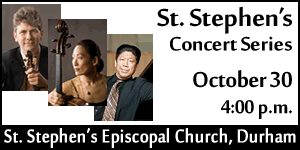If a light flickered last night, it must have been Elvis — or could it have been Carson McCullers, a confirmed believer in extrasensory perception.
The program consisted of electronic music and the world premiere of J. Mark Scearce’s chamber opera A Tree — a Rock — a Cloud (1997), an adaptation of Carson McCullers’ 1942 short story. Penned by the NCSU Music Department Director, the work was performed on the Arts Now! Series at North Carolina State University in Raleigh. It featured tenor Wade Henderson, baritone Krassen Karagiozov, and soprano Pamela Henderson, all from CapOpeRa. The conductor was Alfred E. Sturgis. The thirty-minute opera displayed the talents of a host of contributors. The jazz ensemble consisted of University musicians Greg Gelb, alto sax, Jonathan Kramer, cello, and Wes Parker, trombone. The set design and the costumes, inspired by the Edward Hopper painting Nighthawks (1942), were created by John McIlwee from University Theatre.
Dr. Rodney Waschka, director of Arts Now and the Art Studies program, offered a brief history of electronic music with the presentation of three works beginning with James Tenney’s 1961 “Collage #1,” an early example of musique conrete, followed by Antonio Ferreira’s “More Adult Music” (1987), with text by Waschka. Finally, there was Stan Link’s “Hissarlik,” commissioned for the 2004 Computer Music Festival at the University and based on the poem of John Balaban, Professor of English in creative writing. What unified the two halves of the concert (besides the emphasis on text) was the focus on contemporary compositional practices, which provide layers of texture and color.
There should be no surprise that the short story worked as an opera. Aside from the well-written dialogue of the text, McCullers, who shared a close relationship with composer David Diamond, drew from musical forms in creating literary structures. She was trained as a pianist from a young age and, as a teenager, vowed to become a concert pianist; these seeds were planted by her mother. Casting a spell on her as an infant, Marguerite wished that her daughter would become famous. Sadly, McCullers, like the protagonist in the story, grappled with the mystery of love throughout her troubled life as an artist. And though her work is often described as unsentimental, Scearce’s music draws forth the emotional undercurrents of the story.
Clean shaven and with beatific smile, tenor Wade Henderson sang the Old Man, a character that biographer Virginia Spencer Carr likens to “Coleridge’s Ancient Mariner.” With his powerful instrument, he transformed the lonely character to the heroic. And in moments of tender melody to the text “Men fall in love,” Henderson projected an endearing though tragic figure. Karagiozov, who has a lovely baritone voice but was at times overshadowed by the strength of the tenor, sang the part of the ornery and sometimes sarcastic café owner, Leo, with great sincerity. And Pamela Henderson, perfectly suited for the pants role of the paperboy, sang with such clarity and delicate nuance that the oft’-understated melodic lines rang. Her voice shone brightest in the highest register as she sang text from the emotional centerpiece, “we watch a bird fly up high.”
The jazz combo provided an interesting musical counterpoint to the singers. Inspired by Scearce’s background as a jazz trumpeter, we heard the influence of old-time Creole jazz, strains of Kai Wending and J.J. Johnson duets, and snippets of Charlie Parker’s improvisations. Those fleeting moments wafted above the seemingly simple but intricately worked surface that Scearce refers to as “swaths of color.”
As this serendipitous concoction of talent bubbled forth magically, I’m certain the composer must have been delighted to see his work come to fruition as the audience wrestled with “life’s persistent questions.”
As I left the ballroom, I pictured a stage manager turning out the lights saying, “Thank you and good night!”











